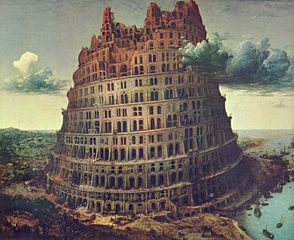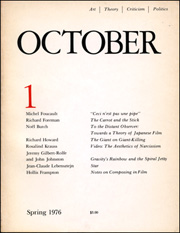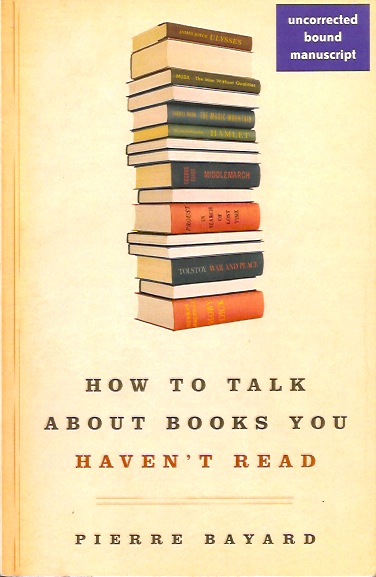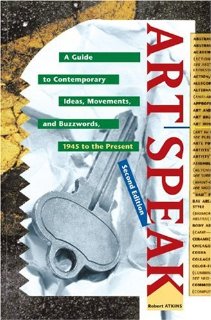 This series of posts began by considering Pierre Bayard’s slender but potent 2007 treatise How to Talk About Books You Haven’t Read, in which said author enthuses over exactly that practice, treating it as not just a necessity in certain social situations but a desideratum. (Too bad Sarah Palin hadn’t come across it before her fateful fall 2008 run-in with Katie Couric.)
This series of posts began by considering Pierre Bayard’s slender but potent 2007 treatise How to Talk About Books You Haven’t Read, in which said author enthuses over exactly that practice, treating it as not just a necessity in certain social situations but a desideratum. (Too bad Sarah Palin hadn’t come across it before her fateful fall 2008 run-in with Katie Couric.)
Which brings me to “International Art English,” a recent report by Alix Rule, a PhD candidate in Sociology at Columbia University, and David Levine, an artist based in Brooklyn and Berlin. Here’s their abstract:
The internationalized art world relies on a unique language. Its purest articulation is found in the digital press release. This language has everything to do with English, but it is emphatically not English. It is largely an export of the Anglophone world and can thank the global dominance of English for its current reach. But what really matters for this language — what ultimately makes it a language — is the pointed distance from English that it has always cultivated.
In what follows, we examine some of the curious lexical, grammatical, and stylistic features of what we call International Art English. We consider IAE’s origins, and speculate about the future of this language through which contemporary art is created, promoted, sold, and understood. Some will read our argument as an overelaborate joke. But there’s nothing funny about this language to its users. And the scale of its use testifies to the stakes involved. We are quite serious.
 They are indeed, though often tongue-in-cheekily so. As a methodology, Rule and Levine concentrated exclusively on press releases issued through e-flux, which they describe as “a listserv that sends out roughly three announcements per day about contemporary-art events worldwide” and “the art world’s flagship digital institution.” They add, “When it comes to communication about contemporary art, e-flux is the most powerful instrument and its metonym.”
They are indeed, though often tongue-in-cheekily so. As a methodology, Rule and Levine concentrated exclusively on press releases issued through e-flux, which they describe as “a listserv that sends out roughly three announcements per day about contemporary-art events worldwide” and “the art world’s flagship digital institution.” They add, “When it comes to communication about contemporary art, e-flux is the most powerful instrument and its metonym.”
Involvement with e-flux takes place from two different directions, that of producers and that of consumers, though participants often play both roles in the international art world. Members of the client base ― nominally non-profit organizations and institutions (museums, festivals, alternative spaces, but not commercial galleries) ― pay e-flux an annual fee in return for the right to send out email bursts of their announcements a certain number of times per year. Those who want to receive these announcements ― which includes “90,000+ visual arts professionals,” a high proportion of them inevitably from the selfsame sources supplying the emails to this system ― subscribe (for free) to this information stream.
Rule and Levine subjected the entirety of what they refer to as the e-flux “corpus” (the total output since its inception) to various forms of statistical and linguistic analysis. I’ve subscribed to e-flux since its debut 13 years ago, which means I’ve received approximately 13,000 emails through this system. e-flux emails all look the same, since the distribution system conforms them layout-wise and typographically to a standardized “house style.” (Here’s a sample.) The source determines the content, however ― headlines, text, image selection and caption. Given the genuinely global client base, one would expect a diversity of vocabularies, phrasings, references, and other components in the releases. Instead, one finds a surprising sameness of thought and locution.
Most of these press releases, Rule and Levine point out in their preamble, are written by interns or junior staffers at these institutions, who with rare exceptions are still in or recently graduated from programs in studio art, art history, museum studies, or arts management ― programs in which the use of a certain “artspeak” vocabulary, grammar, syntax, and canonical reference points has become de rigeur. Moreover (and Rule and Levine don’t mention this, surprisingly), these jejune authors also number among the core demographic of recipients and readers of art-world press releases, certainly including the steady stream from e-flux itself. Not surprising, therefore, that the output of these epigones should prove so homogeneous.
Rule and Levine ask, “How did we end up writing in a way that sounds like inexpertly translated French?” I’m reminded of a colleague’s description of much written artbabble as “aspiring to read as if translated from the German.” Along with American and UK English, French and German represent the languages that predominate in the production of art-related theory. Thus I don’t find it surprising that academic writing styles derived from translations of such materials infiltrate English-language production of such texts. “If e-flux is the crucible of today’s IAE, the journal October is a viable candidate for the language’s point of origin,” Rule and Levine propose, adding, further on, “October’s emulators mimicked both the deliberate and unintentional features of the journal’s writing, without discriminating between the two. . . . [T]he progeny of October elevated accidents of translation to the level of linguistic norms.”
How to Write about Art You Haven’t Seen
What the authors don’t say, perhaps because they didn’t know it, is that many of these press releases get written by people who aren’t just art-world wannabes but individuals who have never laid eyes on the work in question. That is, they’re exercises in “How to Write about Art You Haven’t Seen.” That’s because the publicity cycle in the art world runs on a three-month time lag. Let me explain. (Note that I speak here as a recipient of art-world press releases for the past 45 years, and one who, in his more recent role as curator, has had an involvement in the writing and delivery of press releases as well. I speak also as one who has written for periodicals ranging in publication frequency from quarterly to weekly.)
The logistics of print-media production and distribution determine the schedule under which editorial content gets planned, assigned to writers, selected from incoming materials, and finalized for eventual publication. Monthly magazines such as the major art periodicals ― Artforum, ARTnews, Art in America ― wrap up about three months ahead of the date on which they hit the newsstands and kiosks and get mailed out to subscribers. So, as I write this in mid-April, the editors of those journals are pulling together their July 2013 issues.
For them to include the announcement of a show that will open that month, they need to have the press release in hand today. For them to have it now, someone had to write it and get it approved through channels awhile back, so that the release and its accompanying materials (images for illustration, artist’s CV, etc.) could wend its way through the mails or over the internet to that destination ― Artforum, let’s say. Periodicals that appear on a more frequent schedule (bi-weekly, weekly, daily) get press releases closer to their deadlines. But these will be the same releases drafted months earlier.
![]() However, unless it’s a show drawn from an in-house collection, the works included almost certainly won’t have reached the venue three months ahead of opening day. Given that many institutions now sponsor the premieres of works made to order for them, and that many artists work right up to deadline when producing such commissions, or even generate them from scratch on-site, it’s often the case that no one, including the curators and the artist(s) involved, will have seen the work actualized in its final form until shortly before the opening. And if it’s a new work, and/or a site-specific one, and/or one that involves some ongoing aleatory or performance-based or audience-participation aspects, its idiosyncratic qualities and effects remain indeterminate until completed or concluded.
However, unless it’s a show drawn from an in-house collection, the works included almost certainly won’t have reached the venue three months ahead of opening day. Given that many institutions now sponsor the premieres of works made to order for them, and that many artists work right up to deadline when producing such commissions, or even generate them from scratch on-site, it’s often the case that no one, including the curators and the artist(s) involved, will have seen the work actualized in its final form until shortly before the opening. And if it’s a new work, and/or a site-specific one, and/or one that involves some ongoing aleatory or performance-based or audience-participation aspects, its idiosyncratic qualities and effects remain indeterminate until completed or concluded.
Imagine yourself, then, an intern at Alternative Space X or Museum Y or Biennial Z, charged with writing a press release today for a solo or group show scheduled three months hence, on whose content you’ve never laid eyes. You can perhaps find images of the work online, but, like the projected transparencies of the art-history courses of yesteryear, digital representations emulsify distinctions between visual works of art, deleting most of the relevant information about a work’s physicality or object nature, overemphasizing its iconography. Hardly enough to allow even a pretense of informed description. What to do?
You turn, for expediency’s sake, to what others have said about the work, cobbling together a collage of extracts from artist’s statements and interviews, published reviews, and previous press releases from prior exhibitions by the artist(s), possibly augmented by the notes for or early draft of the curator’s wall label for the upcoming show. You put this into the blender, perhaps adding a few choice items from a glossary such as ArtSpeak : A Guide to Contemporary Ideas, Movements, and Buzzwords, 1945 to the Present, slyly dropping in a dollop from the Postmodernism Generator, hit the purée button, and serve.
If you’ve done your job right, the result will sound just like the e-flux releases to which all involved in this semantic daisychain have become accustomed. Your supervisor in the institution’s publicity department will review and tweak it, as will the curator(s) of the show and, perhaps, even the artist him- or herself. Then out it will go, another dribble into the stream feeding into the river of e-flux PR that empties into the sea of International Art English, where it will mingle with the outflow of that seas’s other tributaries, evaporate, and return as fog, as dew, as rain, in an endless cycle.
Rule and Levine conducted their scholarly study under the sponsorship of Triple Canopy. I think we owe all involved a debt of gratitude for verifying what many of us have long suspected and some (myself included) have openly averred: That a preponderance of contemporary artspeak comes from people talking through their hats, or more crudely put, bullshitting, and doing so by dipping from a small repertoire of stock phrases and ideas, most of them long since emptied of any meaning they might once have had.
•
This post supported by a donation from the Estate of Lyle Bongé.










Leave a Comment